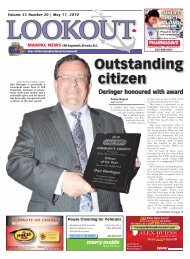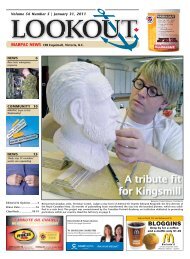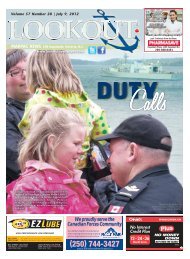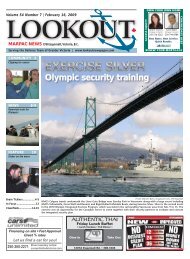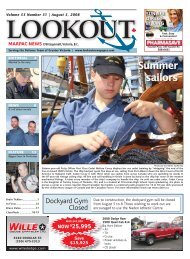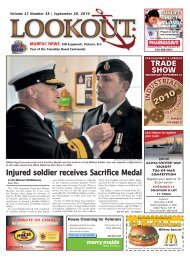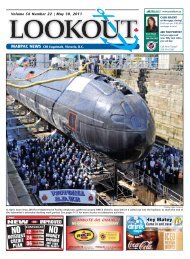Adding history to tribute - Lookout Newspaper
Adding history to tribute - Lookout Newspaper
Adding history to tribute - Lookout Newspaper
You also want an ePaper? Increase the reach of your titles
YUMPU automatically turns print PDFs into web optimized ePapers that Google loves.
February 14, 2011 LOOKOUT • 3<br />
Protecteurʼs crew keeps ships<br />
sailing when things go right<br />
Ben Green<br />
Staff writer<br />
Stepping on<strong>to</strong> the starboard<br />
bridge deck, I’m<br />
greeted by a warm southerly<br />
breeze and a rocking<br />
guitar solo from the<br />
Rolling S<strong>to</strong>nes. Above me<br />
on the uppermost deck,<br />
Mick’s unmistakable voice<br />
blares out “Start Me Up”<br />
from two giant speakers<br />
as an army of blue<br />
hardhats below fervently<br />
prepare for the morning’s<br />
Replenishment at Sea<br />
(RAS).<br />
“They’re going <strong>to</strong> waiting<br />
station, 500 yards off<br />
our quarter,” explains SLt<br />
Jordan Premo, pointing<br />
over my shoulder. “She’ll<br />
signal <strong>to</strong> us she’s ready for<br />
approach.”<br />
Following the direction<br />
of his finger, HMCS<br />
Winnipeg can be seen gliding<br />
on our starboard side<br />
and HMCS Vancouver on<br />
our port. The tight formation<br />
and thunderous tunes<br />
remind me of a scene out<br />
of a Vietnam War movie,<br />
as if we’re travelling up<br />
river <strong>to</strong> engage the enemy.<br />
Rough seas the first<br />
night out of port have left<br />
SLt Premo battered and<br />
bruised, as he was thrown<br />
off the railing getting in<strong>to</strong><br />
his <strong>to</strong>p bunk. Gingerly he<br />
makes his way <strong>to</strong> the edge<br />
of the bridge deck and<br />
points down.<br />
“She comes and lines up<br />
with our fueling probes,”<br />
he continues. “When she’s<br />
ready we fire a gun line<br />
that’s attached <strong>to</strong> a light<br />
messenger, which is then<br />
attached <strong>to</strong> a heavy messenger.”<br />
The messenger system is<br />
an incremental line that is<br />
shot over. The line that’s<br />
shot over is attached <strong>to</strong> the<br />
light messenger who pulls<br />
over the heavy messenger<br />
(a thicker line). A cable,<br />
called a span wire, for the<br />
fuel hose is attached <strong>to</strong><br />
the heavy messenger who<br />
acts as a guiding line for<br />
the massive fuel hose as it<br />
goes across.<br />
Today’s transfer will see<br />
the two frigates receive<br />
fuel simultaneously on<br />
either side of Protecteur.<br />
TOP UP AT SEA<br />
Winnipeg will <strong>to</strong>p up <strong>to</strong><br />
130 cubic metres (130,000<br />
litres, which is enough<br />
<strong>to</strong> fill 2,600 cars) of diesel<br />
and 20 cubic metres<br />
(20,000 litres) of aircraft<br />
fuel, while Vancouver gets<br />
100 cubic metres (100,000<br />
litres) of diesel and five<br />
cubic metres (5,000 litres)<br />
of aircraft fuel.<br />
RAS is a routine procedure<br />
for the crew of<br />
Protecteur, after all it is<br />
the main service the ship<br />
provides. That doesn’t<br />
mean there aren’t dangers.<br />
Anything from engineering<br />
emergencies <strong>to</strong> steering<br />
gear malfunctions can<br />
have catastrophic consequences.<br />
With all three<br />
ships having <strong>to</strong> stay parallel<br />
at a constant speed, and<br />
Vancouver and Winnipeg<br />
only 50 yards away, the<br />
importance of staying in<br />
line is paramount.<br />
“You have <strong>to</strong> keep the<br />
ships in station [in line],”<br />
he says. “Even if you’re<br />
a degree off, you can hit<br />
that suction point [of the<br />
waves] that drags the ships<br />
<strong>to</strong>gether.”<br />
Pho<strong>to</strong>s by Ben Green, <strong>Lookout</strong><br />
Left: Three replenishment at sea veterans, PO1 Corey Young (left),<br />
PO2 Darrell MacKay (centre), and PO1 Kenneth McEvoy (right), enjoy<br />
a moment on HMCS Protecteur’s portside deck before HMC Ships<br />
Vancouver and Winnipeg pull alongside<br />
Above: LS Lee Thibault lines up the light messenger before firing across<br />
<strong>to</strong> the awaiting Vancouver. The beanbag at the end of the gun pulls the<br />
line across, which then acts as a guideline for the heavy messenger and<br />
eventually the fuel hose.<br />
Looking above us, I can<br />
see the yellow-crossed, red<br />
Romeo flag, which signals<br />
a RAS is taking place,<br />
ripple in the wind. The<br />
two frigates circle around<br />
for their final approach,<br />
and SLt Premo guides me<br />
down <strong>to</strong> Protecteur’s brow<br />
where the deck stations<br />
are preparing the fuel lines.<br />
With the deck stations<br />
split in<strong>to</strong> four sections,<br />
two and four on port, one<br />
and three on starboard,<br />
I’m loaned a familiar<br />
blue hardhat and life-vest<br />
and given permission <strong>to</strong><br />
shadow 4 section led by<br />
CPO2 Darrell MacKay,<br />
Chief Boatswain. His 32<br />
years in the navy has seen<br />
him spend more years<br />
on the water than land.<br />
With a permanent smile<br />
and relaxed demeanor, the<br />
Buffer (as he’s known)<br />
oozes confidence in<strong>to</strong> his<br />
young crew.<br />
When the signal is given,<br />
and Vancouver comes<br />
alongside, a few members<br />
from each ship share a<br />
quick wave and a smile;<br />
we won’t be this close<br />
again until Hawaii. Like<br />
SLt Premo said, up steps a<br />
member of 4 section with<br />
what looks <strong>to</strong> be a fluorescent<br />
orange, <strong>to</strong>y rifle with<br />
a beanbag in the barrel.<br />
Pointing it at Vancouver’s<br />
deck, a sharp gunshot<br />
reverberates through the<br />
portside deck as a line<br />
lands on the other side<br />
and a casing rolls quietly<br />
on the floor. The RAS has<br />
started.<br />
Under the guidance of<br />
the Buffer, 4 section sends<br />
over the light and heavy<br />
messengers without issue.<br />
These incremental lines<br />
act as guiding lines for<br />
the much larger fuel hose<br />
<strong>to</strong> be transferred. As the<br />
massive, black fuel hose<br />
unfolds its way across the<br />
frothy channel between<br />
the two ships, the signal<br />
is given <strong>to</strong> latch the probe<br />
(the end of the fuel hose)<br />
in<strong>to</strong> the Vancouver and<br />
start fueling.<br />
Every few minutes,<br />
samples of the fuel being<br />
sent over are gathered and<br />
recorded for liability purposes.<br />
That way each ship<br />
has a record of what quality<br />
of fuel is transferred at<br />
what time.<br />
A rather ordinary 20<br />
minutes goes by until the<br />
signal is given that fueling<br />
is complete. All lines are<br />
slowly collected and the<br />
fuel hose is retracted and<br />
s<strong>to</strong>red away. As Vancouver<br />
peels away full and satisfied,<br />
Winnipeg on the<br />
starboard side is finding<br />
things <strong>to</strong> be more compli-<br />
cated than her Task Group<br />
sister.<br />
All initial procedures<br />
went smoothly except the<br />
probe won’t latch in<strong>to</strong><br />
Winnipeg correctly. A successful<br />
Jackstay for transferring<br />
food, parts, and<br />
other goods at the forecastle<br />
of Protecteur is a silverlining<br />
on what is proving<br />
<strong>to</strong> be an unwinnable battle<br />
with the fuel line.<br />
After about an hour of<br />
unsuccessful attempts, the<br />
call is made <strong>to</strong> end the<br />
RAS and Winnipeg drifts<br />
off without acquiring any<br />
fuel. The plan for <strong>to</strong>morrow<br />
is <strong>to</strong> try again with a<br />
different probe.<br />
Making my way through<br />
the brow between the four<br />
tired deck crews, trays of<br />
“RAS candies” circulate<br />
through the groups for<br />
a job well done. Looking<br />
around at the men and<br />
women, an awaiting SLt<br />
Premo gives me some final<br />
insight in<strong>to</strong> life on board<br />
the supply ship.<br />
“The RAS happens in<br />
stints,” he says. “One week<br />
you’ll have nothing, one<br />
day you’ll have two, you<br />
have <strong>to</strong> be prepared.”<br />
Nodding, I remove my<br />
hardhat and graciously<br />
accept a strawberry flavored<br />
candy. For a moment<br />
I feel like part of the crew.





